

Most ebook files are in PDF format, so you can easily read them using various software such as Foxit Reader or directly on the Google Chrome browser.
Some ebook files are released by publishers in other formats such as .awz, .mobi, .epub, .fb2, etc. You may need to install specific software to read these formats on mobile/PC, such as Calibre.
Please read the tutorial at this link: https://ebookbell.com/faq
We offer FREE conversion to the popular formats you request; however, this may take some time. Therefore, right after payment, please email us, and we will try to provide the service as quickly as possible.
For some exceptional file formats or broken links (if any), please refrain from opening any disputes. Instead, email us first, and we will try to assist within a maximum of 6 hours.
EbookBell Team

4.1
50 reviewsThe concept of Flow was first explained by Csikszentmihalyi (1975), described as an “optimal experience,” he noted that artists were entirely caught up in their projects, working feverishly to finish them and then lose all interest in their work after completion. The incentive lies in the act of creativity itself. The person feels optimally challenged while totally immersed in the activity. At the heart of flow research is the motivational aspect of this experience. Flow motivates people to carry out certain activities repeatedly, seeking a challenge in the act and looking to improve their skills and abilities. In this book, this motivational aspect will be imbedded in and related to other theories of (intrinsic) motivation and empirical work on flow and performance. The book provides a review of the current flow research, with a focus on rigorous analysis on methodology. The author takes the time to present methodological aspects in flow research to qualify empirical work. In addition, this volume presents neuropsychological considerations and empirical correlates of flow experiences. The work also describes various theoretical integrations of the different paths being taken within the field of flow research. It presents what has been learned since the beginning of flow research, what is still open, and how the mission to understand and foster flow experience research should continue.